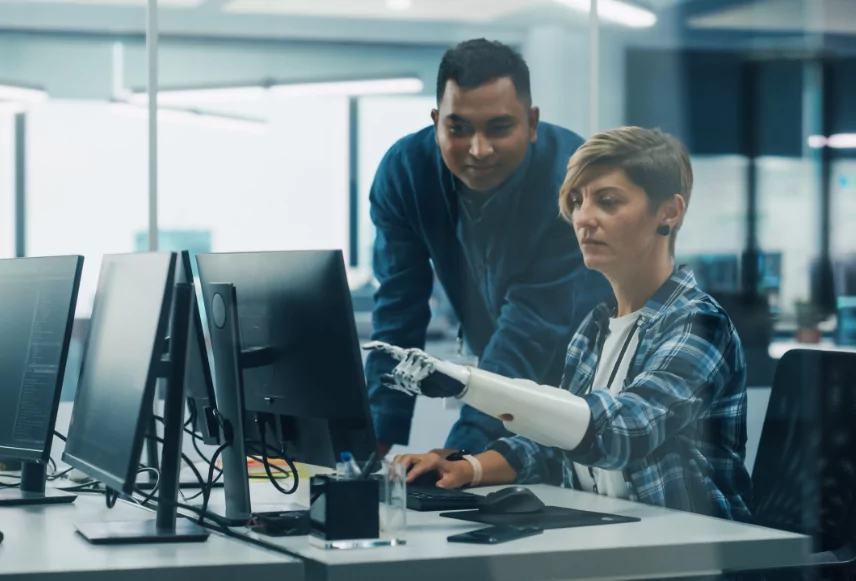
Harnessing the power of Generative AI in onboarding is a great way to unleash the true potential of today’s workforce. Generative AI offers various benefits such as automated onboarding, personalized learning and engagement, streamlined HR processes, increased HR productivity, reduced HR response time, and more accurate and objective performance evaluations.
We are living in a massive technological revolution, where the introduction of Generative AI has intrigued and reshaped the world at an unprecedented pace. In this fast-evolving technological world, tapping into the strength of such advancements is the key to coping with the ever-increasing speed of technological transformation.
According to Precedence Research, the global Generative AI in HR market size is projected to reach around $2,091.4 million by 2032 while growing at a CAGR of 15.77% during the forecast period 2023-2032.
Generative AI empowers organizations to create tailor-made onboarding experiences. To learn how to implement Generative AI to personalize and transform the onboarding experience, watch our Power Hour on the ‘Role of Generative AI in Onboarding and Learning.’
This insightful discussion was hosted by Anushree Sharma, Associate Director, Harbinger Group and featured industry experts, Tracie Sponenberg, Chief People Officer, The Granite Group; Stephen Lytle, Human Resources Director, ChenMed; and Prashant Khambekar, Senior Vice President, Harbinger Group.
Use Cases for Integrating Generative AI in Onboarding
Each new hire brings unique skills, perspectives, and experiences to an organization. With the help of Generative AI in onboarding, HR professionals can help revolutionize how organizations welcome and nurture their new employees.
Let’s talk about a few use cases of Generative AI that can make the onboarding process hassle-free and more effective for both the HR department and new hires.
1. Personalized New Hire Query Resolution
During onboarding, new employees often have several questions regarding company policies, benefits, work culture, and roles. Traditional methods like FAQs and manuals might not cover all the possible queries, leaving new hires frustrated and uncertain.
With Generative AI in onboarding, HR teams can develop chatbots or virtual assistants that are capable of understanding and responding to natural language queries. These AI-powered assistants can access a vast database of information including company policies and employee handbooks to provide accurate and personalized answers to each new hire’s questions.
2. Automated Document Intake and Verification
Integrating Generative AI in onboarding can streamline document intake and verification procedures, reducing manual efforts and minimizing errors.
Generative AI algorithms can automatically extract relevant information from the submitted documents and cross-verify them against pre-defined criteria. This automation not only expedites the onboarding process but also ensures a higher level of accuracy and compliance.

3. Self-Paced Learning of Policies and Culture
One of the crucial aspects of successful onboarding is ensuring that new employees comprehend and align with the company’s policies, values, and culture.
By incorporating Generative AI-driven interactive eLearning modules or gamified content, organizations can offer new employees an engaging and personalized way to learn about the company’s ethos. These modules can adapt to the individual learning preferences and progress, making the onboarding process more efficient.
Harbinger helped an HCM software vendor integrate its onboarding solution system with an external ATS, enabling automated data exchange between the two platforms. This integration resulted in a seamless end-to-end hiring and onboarding experience for customers.
4. Personalized Learning of Domain Knowledge
Generative AI algorithms can analyze the new hire’s prior experience and current job role and curate a tailored learning path. This path may include online courses, interactive training materials, or mentorship opportunities that align with the new employee’s skill set and career aspirations.
As a result, new hires can quickly acquire the necessary domain knowledge and skills, accelerating their integration into the workforce and maximizing their potential impact on the organization.
5. Nudge Strategies
Nudge strategies serve as a smart approach to onboarding, leveraging human psychology to motivate users to take the desired actions. When implemented in the right way, these nudges seamlessly blend into the user experience without causing any interruption or annoyance.
By carefully sequencing the nudges, the onboarding process can be enhanced, ensuring a smooth user flow. Unlike traditional onboarding tools, nudges are non-intrusive, cost-effective, and offer superior benefits.
Apps that utilize nudges can create a more enjoyable and engaging journey for new hires during onboarding. To achieve effective and efficient results in the onboarding experience, HR organizations can utilize auto-generated reinforcement nuggets.
5 Steps to Integrate Generative AI in Onboarding
Consider a situation where a new employee feels less than comfortable in the initial days of a new job. This forms a poor impression of the employer on the new employee, which can never be erased. So how can organizations do a better job with onboarding on those first few critical days of new hires at work? Well, the solution is Generative AI.
By leveraging Generative AI, organizations can reduce the stress on a new hire, make the onboarding process smoother and more efficient, and offer a human connection.
In this digital age, where automation and Generative AI are reshaping various business functions, integrating Generative AI in onboarding programs presents a unique opportunity to create truly immersive experiences for new hires.
Now that we understand the possibilities and use cases of Generative AI in onboarding, let’s learn how to implement this advanced technology. We have outlined a series of steps to help you seamlessly integrate Generative AI in onboarding. Without further ado, let’s dive in and explore together.

1. Assessment and Planning
Begin by evaluating your onboarding process and identifying areas that can benefit from Generative AI integration. Determine the specific objectives you want to achieve through AI, such as personalized content, virtual mentorship, or chatbot support. Collaborate with HR and IT teams to outline a roadmap for the Generative AI implementation, considering budget, resources, and timelines.
2. Data Collection and Preprocessing
Generative AI relies on large datasets to generate meaningful and relevant content. Gather historical onboarding data, learning materials, and employee feedback to build a comprehensive dataset. Ensure the data is accurate, diverse, and complying with privacy regulations. Preprocess the data to remove inconsistencies, creating a clean dataset ready for Generative AI model training.
3. Generative AI Model Selection and Training
Choose the appropriate Generative AI model that aligns with your onboarding objectives. Options may include GPT-4, BERT, or other language models, depending on the complexity of tasks you want to automate.
Pretrained models can be fine-tuned on your dataset to make them more contextually relevant to your organization. Train the Generative AI model using powerful hardware and distributed computing to optimize performance and reduce training time.
4. Personalized Content Generation
Use the trained model to generate personalized onboarding content for each new hire. This content could include role-specific learning modules, video tutorials, and relevant resources based on individual skills and preferences.
5. Chatbot Integration and Support
Integrate Generative AI-powered chatbots into your onboarding process to provide continuous support and assistance to new hires. These chatbots can answer common queries, guide new hires through administrative procedures, and offer resources on demand.
Learn how Harbinger automated HR ticket resolution and increased HR efficiency by implementing a cloud-based chatbot solution. There was a significant improvement in ticketing productivity, with the response time reduced from 3-5 minutes to 1.30 seconds.
Summing Up
Generative AI represents a groundbreaking advancement in employee onboarding. By leveraging the power of Generative AI, organizations can create a highly efficient onboarding process and an engaging experience for new hires.
While Generative AI can automate onboarding, it is important to apply the human touch to the overall process. Balancing automation with personal interactions helps create a welcoming and supportive onboarding experience. Additionally, regularly updating and fine-tuning the AI system based on employee feedback will ensure its effectiveness over time.
Are you seeking a helping hand to integrate Generative AI in onboarding? Write to us at contact@harbingergroup.com and explore transformative HRTech solutions to achieve your business goals.






